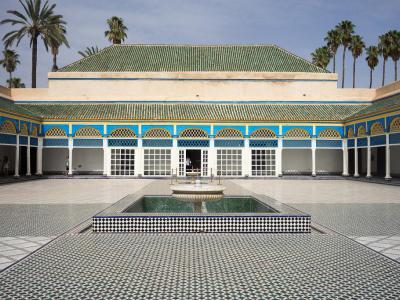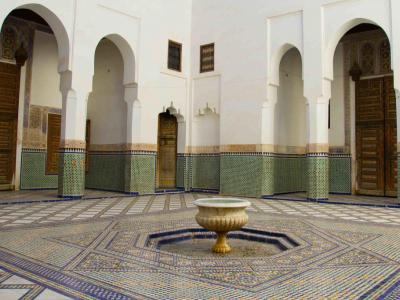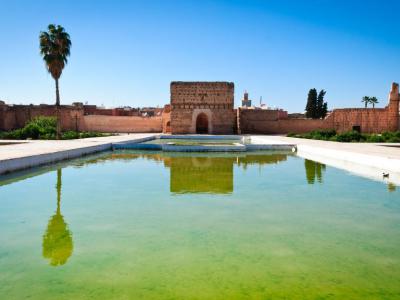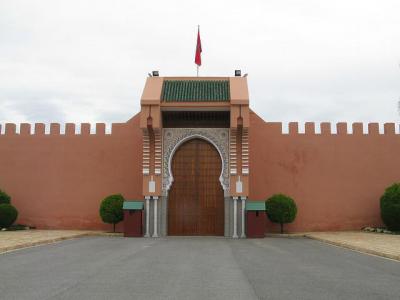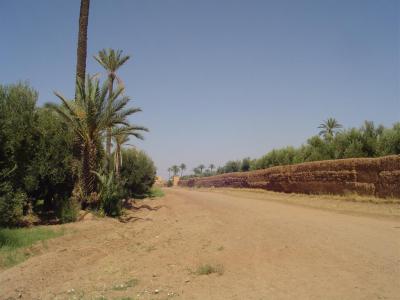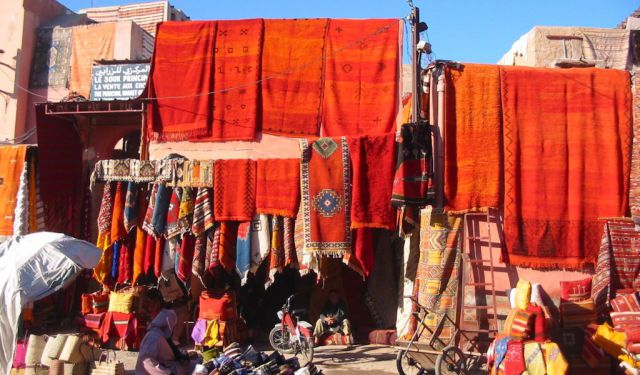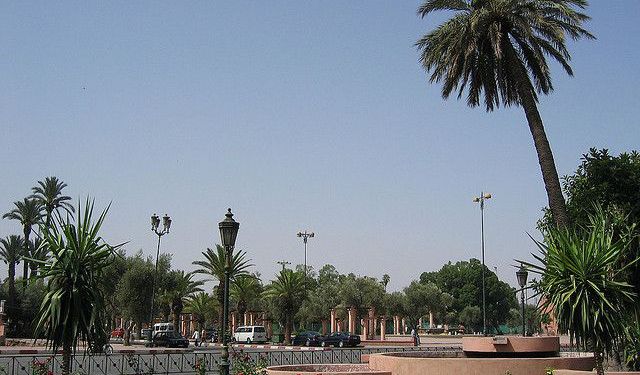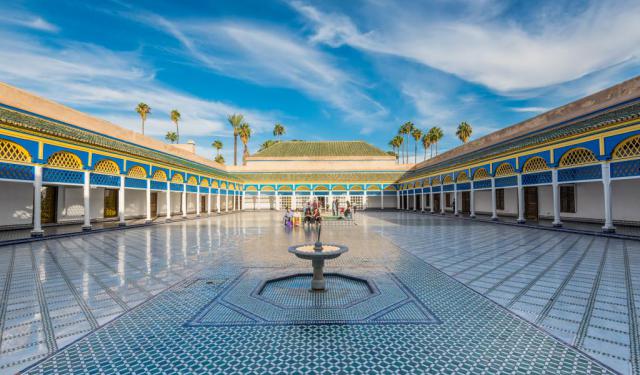
Moroccan Palaces Walking Tour (Self Guided), Marrakech
One of the meaningful ways to pass the time away in Marrakech is to visit the local palaces. This is particularly true given that some of them, now restored and refurbished, function as museums. Others, on the other hand, are slowly turning into ruins, which is sad. Nonetheless, they all have a long story to tell and spectacular architecture fit to amaze any beholder.
Among the most renowned palaces in the city is Bahia Palace, an architectural marvel with intricate designs and enclosed gardens. This 19th-century palace is a testament to Moroccan craftsmanship, featuring stunning mosaic tiles, ornate ceilings, and beautifully landscaped courtyards that offer a glimpse into the opulent lifestyle of the past.
The Museum of Moroccan Arts (Musee Dar Si Said) is another palatial treasure. Housed in a late-19th-century palace, it displays a remarkable collection of Moroccan arts and crafts, including textiles, ceramics, jewelry, and woodwork.
El Badi, once a sumptuous palace known for its grandeur, today stands in ruins. Still, its remnants, dating back to the 16th century, tell a fascinating story. Despite its current state, the El Badi complex remains an intriguing historical site.
The Royal Palace of Marrakech, also known as Dar al Makhzen, is a majestic palace that serves as the official residence of the Moroccan king when he visits the city. While the palace is not open to the public, its grand entrance and massive golden gates are a sight to behold.
Finally, Agdal Gardens, a vast royal garden located near the Royal Palace, is a tranquil oasis of greenery. The gardens feature beautifully landscaped grounds, orchards, and large water reservoirs, providing a serene escape from the urban hustle and bustle.
For any traveler seeking to discover the magic of Morocco, exploring the palatial treasures of Marrakech offers a glimpse into the country's majestic heritage. Embarking on this self-guided tour will enable you to enjoy the grandeur and mystic atmosphere of these grandiose buildings.
Among the most renowned palaces in the city is Bahia Palace, an architectural marvel with intricate designs and enclosed gardens. This 19th-century palace is a testament to Moroccan craftsmanship, featuring stunning mosaic tiles, ornate ceilings, and beautifully landscaped courtyards that offer a glimpse into the opulent lifestyle of the past.
The Museum of Moroccan Arts (Musee Dar Si Said) is another palatial treasure. Housed in a late-19th-century palace, it displays a remarkable collection of Moroccan arts and crafts, including textiles, ceramics, jewelry, and woodwork.
El Badi, once a sumptuous palace known for its grandeur, today stands in ruins. Still, its remnants, dating back to the 16th century, tell a fascinating story. Despite its current state, the El Badi complex remains an intriguing historical site.
The Royal Palace of Marrakech, also known as Dar al Makhzen, is a majestic palace that serves as the official residence of the Moroccan king when he visits the city. While the palace is not open to the public, its grand entrance and massive golden gates are a sight to behold.
Finally, Agdal Gardens, a vast royal garden located near the Royal Palace, is a tranquil oasis of greenery. The gardens feature beautifully landscaped grounds, orchards, and large water reservoirs, providing a serene escape from the urban hustle and bustle.
For any traveler seeking to discover the magic of Morocco, exploring the palatial treasures of Marrakech offers a glimpse into the country's majestic heritage. Embarking on this self-guided tour will enable you to enjoy the grandeur and mystic atmosphere of these grandiose buildings.
How it works: Download the app "GPSmyCity: Walks in 1K+ Cities" from Apple App Store or Google Play Store to your mobile phone or tablet. The app turns your mobile device into a personal tour guide and its built-in GPS navigation functions guide you from one tour stop to next. The app works offline, so no data plan is needed when traveling abroad.
Moroccan Palaces Walking Tour Map
Guide Name: Moroccan Palaces Walking Tour
Guide Location: Morocco » Marrakech (See other walking tours in Marrakech)
Guide Type: Self-guided Walking Tour (Sightseeing)
# of Attractions: 5
Tour Duration: 1 Hour(s)
Travel Distance: 2.7 Km or 1.7 Miles
Author: ann
Sight(s) Featured in This Guide:
Guide Location: Morocco » Marrakech (See other walking tours in Marrakech)
Guide Type: Self-guided Walking Tour (Sightseeing)
# of Attractions: 5
Tour Duration: 1 Hour(s)
Travel Distance: 2.7 Km or 1.7 Miles
Author: ann
Sight(s) Featured in This Guide:
- Bahia Palace
- Musee Dar Si Said (Museum of Moroccan Arts)
- El Badi Palace
- Royal Palace of Marrakech
- Agdal Gardens
1) Bahia Palace (must see)
Designed to be the greatest of its time, this late 19th century palace, whose name translates to the "palace of the brilliant/beautiful", sure does live up to its title. Extended over 8 hectares, one of which is a garden, the Bahia Palace complex offers an oasis of quiet from traffic noise and the bustle of the adjacent medina souk; its rooms and courtyards dazzle the eye with intricate, colorful tile work, mosaics, colored glass, fine carvings, and elaborate ceilings.
Situated close to the royal El Badi Palace and about 900 meters southeast of Jemaa el-Fnaa, the Bahia was built for Si Moussa, the Grand Vizier of Sultan Hassan I. At the time, it was Morocco's largest and most luxurious palace, comprising 150 rooms (a subset is open to the public), with attached patios, courtyards, fountains, and gardens. Furthermore, during the French Protectorate, it was the residence of General Hubert Lyautey, who added electricity, fireplaces, and heating.
While the area open to visitors is not huge (you can walk around in about 30mins if you are limited on time), it is nice to spend a little longer taking it all in. Regrettably, the rooms lack period furniture, but the stunning tiled walls and ceilings make up for it.
Tip:
Although you can wander around on your own, it is wise to hire a guide as there is little information in English, and you can get lost.
Situated close to the royal El Badi Palace and about 900 meters southeast of Jemaa el-Fnaa, the Bahia was built for Si Moussa, the Grand Vizier of Sultan Hassan I. At the time, it was Morocco's largest and most luxurious palace, comprising 150 rooms (a subset is open to the public), with attached patios, courtyards, fountains, and gardens. Furthermore, during the French Protectorate, it was the residence of General Hubert Lyautey, who added electricity, fireplaces, and heating.
While the area open to visitors is not huge (you can walk around in about 30mins if you are limited on time), it is nice to spend a little longer taking it all in. Regrettably, the rooms lack period furniture, but the stunning tiled walls and ceilings make up for it.
Tip:
Although you can wander around on your own, it is wise to hire a guide as there is little information in English, and you can get lost.
2) Musee Dar Si Said (Museum of Moroccan Arts)
The Museum of Moroccan Art (Musée Dar Si Saïd) is located in one of Marrakech’s most beautiful palaces, and is a calm and interesting place to spend a few hours. The word Dar means “house”, while Si Saïd is part of the name of Si Saïd ibn Moussa, the Minister of War, for whom this palace was built in the mid 19th century and whose brother was the Vizier Bou Ahmed.
By far more than just a simple townhouse, this magnificent building features a number of amenities, such as a superb courtyard full of flowers and cypress trees, a gazebo and a fountain. The exhibition rooms around the courtyard are embellished with intricately carved doors, extraordinary stucco-work and mosaics. In addition to these, visitors can also explore the domed reception room and harem quarters.
The museum collection is considered to be one of the finest in Morocco, with jewelry from the High Atlas, the Anti Atlas and the extreme south; carpets from the Haouz and the High Atlas; oil lamps from Taroudannt; blue pottery from Safi and green pottery from Tamgroute; and leather-work from Marrakech.
But the true jewel of the collection is a 10th-century Spanish marble basin, which was brought to Marrakech by the Sultan Ali ben Youssef in 1120. Initially, he put it in the mosque, even though it carried images of an eagle and griffons carved upon which is contrary to the Islamic law prohibiting decorations depicting living creatures. Eventually, under the Saadian dynasty, the basin was moved to the Ben Youssef Madrasa, and then, after the college was restored, donated to the museum.
Why You Should Visit:
The palace is always worth a visit for its wonderful interior, especially now that is has been renovated.
The main public areas are now filled with antique carpets showcasing the different styles found in Morocco.
If you have no previous knowledge of Moroccan carpets, this wonderful exhibition will give you some valuable insight into the remarkable variety of styles & colors available in the country.
By far more than just a simple townhouse, this magnificent building features a number of amenities, such as a superb courtyard full of flowers and cypress trees, a gazebo and a fountain. The exhibition rooms around the courtyard are embellished with intricately carved doors, extraordinary stucco-work and mosaics. In addition to these, visitors can also explore the domed reception room and harem quarters.
The museum collection is considered to be one of the finest in Morocco, with jewelry from the High Atlas, the Anti Atlas and the extreme south; carpets from the Haouz and the High Atlas; oil lamps from Taroudannt; blue pottery from Safi and green pottery from Tamgroute; and leather-work from Marrakech.
But the true jewel of the collection is a 10th-century Spanish marble basin, which was brought to Marrakech by the Sultan Ali ben Youssef in 1120. Initially, he put it in the mosque, even though it carried images of an eagle and griffons carved upon which is contrary to the Islamic law prohibiting decorations depicting living creatures. Eventually, under the Saadian dynasty, the basin was moved to the Ben Youssef Madrasa, and then, after the college was restored, donated to the museum.
Why You Should Visit:
The palace is always worth a visit for its wonderful interior, especially now that is has been renovated.
The main public areas are now filled with antique carpets showcasing the different styles found in Morocco.
If you have no previous knowledge of Moroccan carpets, this wonderful exhibition will give you some valuable insight into the remarkable variety of styles & colors available in the country.
3) El Badi Palace (must see)
All that remains of the once stately El Badi Palace are the extensive ruins, so when you visit it and walk among the remains, spare a thought for the ghosts of past splendors.
Fresh from his victory over the Portuguese in the Battle of the Three Kings in 1572, the Sultan Ahmed el-Massour of the Saadian Dynasty ordered a palace to be built in celebration. He wanted it to be the most important building in Marrakech and named it “Incomparable”. Sadly, the sultan died before its completion in 1603.
Today it is hard to imagine just how magnificent this palace really was with its 360 rooms around the interior courtyard that measured 135 meters by 110 meters and was full of fountains and an enormous pond. However bare the current form, its sheer size is still impressive.
Most of it was paid for by the punishing reparation debt imposed on Portugal after the battle; the mosaics came from Italy, exchanged against sugar in lieu of money, and the gold fittings came from the gold mines of Sudan. Onyx, ivory, cedar wood, and semi-precious stones completed the original interior.
In 1683, after the Saadian Dynasty fell to the Alaouites, the new Sultan Moulay Ismail removed anything that had any value from the palace to decorate his new palace in another town, and El Badi slowly fell into ruin.
An internal staircase (look for a sign on the wall) on the northeast side leads to a small terrace overlooking the complex, giving you an idea of its size and organization. A small museum contains the restored 12th-century intricately carved 'minbar' (Imam's pulpit) from the nearby Koutoubia Mosque.
Why You Should Visit:
Huge and beautiful palace to wander around with lots to see, including a network of underground passageways, tile floors in rooms open to the sky, and a well-preserved minbar.
Tip:
Unfortunately (for English speakers), the majority of posted information about the complex is in Arabic and French; however, the short video in English gives a good overview of the palace's history, construction, layout and original appearance. Hiring an Engish-speaking guide will greatly improve your appreciation of El Badi.
As you wander around the complex, look for stork nests on some of the higher walls.
Inside the palatial complex there is little shade, so a visit early in the morning will be both cooler and sparing the need to stand a long line for tickets.
Bring water and snacks, as no refreshments are available on site.
Fresh from his victory over the Portuguese in the Battle of the Three Kings in 1572, the Sultan Ahmed el-Massour of the Saadian Dynasty ordered a palace to be built in celebration. He wanted it to be the most important building in Marrakech and named it “Incomparable”. Sadly, the sultan died before its completion in 1603.
Today it is hard to imagine just how magnificent this palace really was with its 360 rooms around the interior courtyard that measured 135 meters by 110 meters and was full of fountains and an enormous pond. However bare the current form, its sheer size is still impressive.
Most of it was paid for by the punishing reparation debt imposed on Portugal after the battle; the mosaics came from Italy, exchanged against sugar in lieu of money, and the gold fittings came from the gold mines of Sudan. Onyx, ivory, cedar wood, and semi-precious stones completed the original interior.
In 1683, after the Saadian Dynasty fell to the Alaouites, the new Sultan Moulay Ismail removed anything that had any value from the palace to decorate his new palace in another town, and El Badi slowly fell into ruin.
An internal staircase (look for a sign on the wall) on the northeast side leads to a small terrace overlooking the complex, giving you an idea of its size and organization. A small museum contains the restored 12th-century intricately carved 'minbar' (Imam's pulpit) from the nearby Koutoubia Mosque.
Why You Should Visit:
Huge and beautiful palace to wander around with lots to see, including a network of underground passageways, tile floors in rooms open to the sky, and a well-preserved minbar.
Tip:
Unfortunately (for English speakers), the majority of posted information about the complex is in Arabic and French; however, the short video in English gives a good overview of the palace's history, construction, layout and original appearance. Hiring an Engish-speaking guide will greatly improve your appreciation of El Badi.
As you wander around the complex, look for stork nests on some of the higher walls.
Inside the palatial complex there is little shade, so a visit early in the morning will be both cooler and sparing the need to stand a long line for tickets.
Bring water and snacks, as no refreshments are available on site.
4) Royal Palace of Marrakech
While not open to the public, the Royal Palace is worthwhile going to, as it is perhaps the largest of its kind in the country and has been used as winter quarters by royal families for centuries. It is an enclave within the medina – or a city within the city.
The first palace was built after the Almohad tribe won the city in 1147 following many years of battles against the ruling Almoravides, who had made Marrakech their capital city. When the Almohad Dynasty was installed they pulled down almost all the buildings constructed by their rivals and built the Kasbah within the city walls.
Part of the Kasbah housed military and administrative staff, but most of it was given over to the royal quarters where the sultan lived and housed his harem. The Almohad Dynasty was succeeded by the Marinid Dynasty in 1269 and they enlarged the palace.
The Marinids were succeeded by the Wattasid’s in 1472 who were defeated by the Saadis in 1554. In 1666 the Alaouite Dynasty was installed and their descendants rule Morocco today.
During this time, although most of the buildings in the medina were either destroyed or pulled down so that each dynasty could stamp its name on the city, the palace was simply enlarged and renovated.
Today the capital of Morocco is Rabat, but this hasn’t diminished the importance of the Royal Palace in Marrakech. In 1989 the Unification Treaty of the Arab Maghreb and in 1994 the GATT contracts were signed here.
The first palace was built after the Almohad tribe won the city in 1147 following many years of battles against the ruling Almoravides, who had made Marrakech their capital city. When the Almohad Dynasty was installed they pulled down almost all the buildings constructed by their rivals and built the Kasbah within the city walls.
Part of the Kasbah housed military and administrative staff, but most of it was given over to the royal quarters where the sultan lived and housed his harem. The Almohad Dynasty was succeeded by the Marinid Dynasty in 1269 and they enlarged the palace.
The Marinids were succeeded by the Wattasid’s in 1472 who were defeated by the Saadis in 1554. In 1666 the Alaouite Dynasty was installed and their descendants rule Morocco today.
During this time, although most of the buildings in the medina were either destroyed or pulled down so that each dynasty could stamp its name on the city, the palace was simply enlarged and renovated.
Today the capital of Morocco is Rabat, but this hasn’t diminished the importance of the Royal Palace in Marrakech. In 1989 the Unification Treaty of the Arab Maghreb and in 1994 the GATT contracts were signed here.
5) Agdal Gardens
Marrakech is often very hot and dusty and is always busy and noisy and after a while it’s necessary to escape and relax somewhere calm. Agdal Gardens is an excellent place for this.
The gardens cover an area of 400 hectares to the south of the Royal Palace. Agdal means walled meadow in Berber and the gardens have a pisé wall around them.
They were founded in 1157 as a private orchard for Sultan Abd al-Mu’min. They were renovated and enlarged in the 19th century during the Saadian Dynasty, which was when the wall was erected.
The oblong plots are full of apricot, fig, lemon, orange and pomegranate trees, linked by paths lined with olive trees.
There are several ponds and the whole area is irrigated by khettera – which are ingenious underground channels that bring water from the Ourika Valley in the High Atlas Mountains.
The largest pool is called the “Tank of Health” and was once used for teaching soldiers how to swim. Beside this pool you will see the minzah Dar el Hana, where various sultans would spend a few days during the summer months to escape the heat of the city. Another pavilion in the gardens is the Dar al Baida, which housed the sultan’s harem.
The gardens cover an area of 400 hectares to the south of the Royal Palace. Agdal means walled meadow in Berber and the gardens have a pisé wall around them.
They were founded in 1157 as a private orchard for Sultan Abd al-Mu’min. They were renovated and enlarged in the 19th century during the Saadian Dynasty, which was when the wall was erected.
The oblong plots are full of apricot, fig, lemon, orange and pomegranate trees, linked by paths lined with olive trees.
There are several ponds and the whole area is irrigated by khettera – which are ingenious underground channels that bring water from the Ourika Valley in the High Atlas Mountains.
The largest pool is called the “Tank of Health” and was once used for teaching soldiers how to swim. Beside this pool you will see the minzah Dar el Hana, where various sultans would spend a few days during the summer months to escape the heat of the city. Another pavilion in the gardens is the Dar al Baida, which housed the sultan’s harem.
Walking Tours in Marrakech, Morocco
Create Your Own Walk in Marrakech
Creating your own self-guided walk in Marrakech is easy and fun. Choose the city attractions that you want to see and a walk route map will be created just for you. You can even set your hotel as the start point of the walk.
Marrakech Top Religious Sites
Islam is the official religion in Morocco, which is why it is only natural that mosques are the dominant religious sites in the country, and Marrakech is no exception. Outside these places of worship, the city's religious scene is represented by unique historical monuments (koubbas), cemeteries, and mausoleums – all quite interesting to explore.
Our journey starts with the Ben Youssef... view more
Tour Duration: 1 Hour(s)
Travel Distance: 2.7 Km or 1.7 Miles
Our journey starts with the Ben Youssef... view more
Tour Duration: 1 Hour(s)
Travel Distance: 2.7 Km or 1.7 Miles
Moroccan Architecture Walking Tour
No tall skyscrapers, no sophisticated giant malls, no anything else of Western architecture await you on this tour. Our self-guided walk is entirely about the genuine Moroccan style. We are going to reveal Marrakech which will amaze you with its majestic structures, traditional motifs, and mystic atmosphere.
Our first stop is a prominent example of Islamic architecture, the Koutoubia Mosque.... view more
Tour Duration: 3 Hour(s)
Travel Distance: 4.6 Km or 2.9 Miles
Our first stop is a prominent example of Islamic architecture, the Koutoubia Mosque.... view more
Tour Duration: 3 Hour(s)
Travel Distance: 4.6 Km or 2.9 Miles
Marrakech Shopping Tour
Shopping in Marrakech is an extraordinary experience that captivates the senses. Perhaps no other shopping in your life will compare to it: vivid, bright, juicy colors of carpets, clothes, and shoes; enchanting smells of local perfumes and spices; crafts, handmade jewelry, pottery; and of course, the long shopping mazes and souks.
One of the most iconic shopping destinations in Marrakech is... view more
Tour Duration: 1 Hour(s)
Travel Distance: 1.0 Km or 0.6 Miles
One of the most iconic shopping destinations in Marrakech is... view more
Tour Duration: 1 Hour(s)
Travel Distance: 1.0 Km or 0.6 Miles
Medina Walking Tour
Marrakech Medina is a historic district dating back to the Middle Ages. Listed as a UNESCO World Heritage Site since 1985, this ancient walled city is a labyrinthine maze of narrow streets and bustling markets, known as souks, where you can immerse yourself in the local way of life.
One of the most iconic spots here is Jemaa el-Fnaa, a bustling square that comes alive with street performers,... view more
Tour Duration: 1 Hour(s)
Travel Distance: 1.9 Km or 1.2 Miles
One of the most iconic spots here is Jemaa el-Fnaa, a bustling square that comes alive with street performers,... view more
Tour Duration: 1 Hour(s)
Travel Distance: 1.9 Km or 1.2 Miles
Marrakech Introduction Walking Tour
The fourth largest city in Morocco, Marrakech is a true out-of-the-ordinary getaway combining old historic atmosphere with a lively sights of today. The medina quarter of Marrakech – a UNESCO World Heritage Site – comprises a medieval walled city, dating back hundreds of years to the days of Berber Empire, whose mazelike alleys are still densely packed with vendors and stalls luring buyers... view more
Tour Duration: 2 Hour(s)
Travel Distance: 3.9 Km or 2.4 Miles
Tour Duration: 2 Hour(s)
Travel Distance: 3.9 Km or 2.4 Miles
Gueliz Walking Tour
Gueliz, also known as the New City (Nouvelle Ville), is more like the downtown of Marrakech. Here you will definitely feel the Western influence: McDonald's, KFC, brand stores, and even a supermarket. Still, Gueliz is also famous for its art galleries and parks.
We'll start our acquaintance with Gueliz in the El-Harti Gardens (Jnane El Harti), a peaceful oasis amidst the bustling... view more
Tour Duration: 2 Hour(s)
Travel Distance: 3.1 Km or 1.9 Miles
We'll start our acquaintance with Gueliz in the El-Harti Gardens (Jnane El Harti), a peaceful oasis amidst the bustling... view more
Tour Duration: 2 Hour(s)
Travel Distance: 3.1 Km or 1.9 Miles
The Most Popular Cities
/ view all
